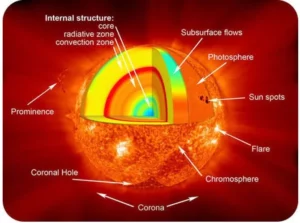GS1 – Geography

Context:
Indian scientists have successfully charted the plasma movements within the Sun’s Near-Surface Shear Layer.
About NSSL
The Near-Surface Shear Layer is a turbulent zone extending roughly 35,000 km beneath the Sun’s visible surface, where a significant drop in plasma rotational speed with increasing depth is observed.
Within this layer, the Sun’s rotation rate declines sharply with radius, leading to a rotational shear that varies based on depth, solar latitude, and magnetic activity.
Key Observations
- Plasma motion in the NSSL follows the Sun’s 11-year magnetic (sunspot) cycle.
- At latitudes where sunspots are active, plasma near the surface flows inward, but reverses direction at mid-depth within the NSSL, moving outward and creating circular flow patterns.
- These flows are shaped by the Sun’s rotation and Coriolis force, resembling atmospheric circulation patterns on Earth.
- Localized plasma motions in the NSSL contribute to rotational shear but don’t explain large-scale torsional oscillations, indicating the presence of unknown deeper processes.
Research Methods
- The study used helioseismology, analyzing solar sound waves to map internal plasma behavior.
- Over ten years of data from NASA’s Solar Dynamics Observatory (SDO) and the National Solar Observatory (NSO) were utilized.
- Three-dimensional velocity mapping of sunspot areas confirmed the presence of surface inflows and corresponding outflows at greater depths.
Why It Matters
- This research deepens our knowledge of solar magnetic fields, the behavior of sunspots, and how the Sun rotates internally.
- It is essential for improving solar weather forecasting, which has practical implications for satellite operations, electrical infrastructure, and communication systems on Earth.




